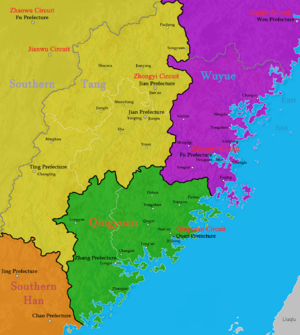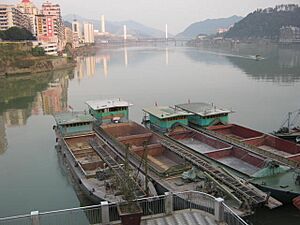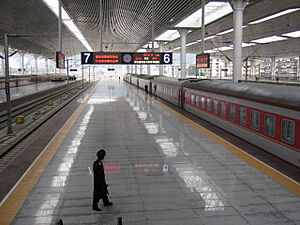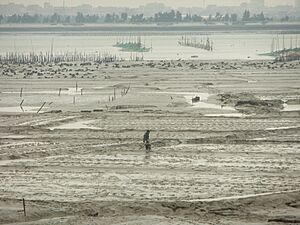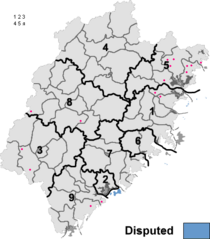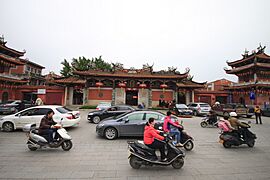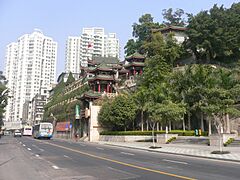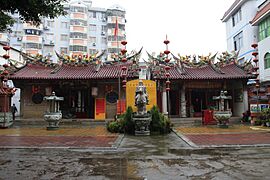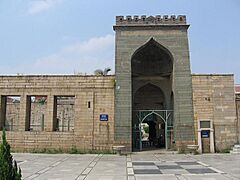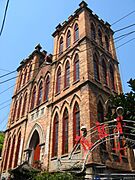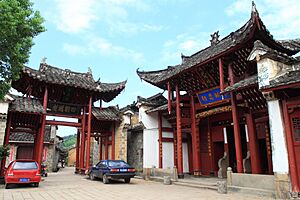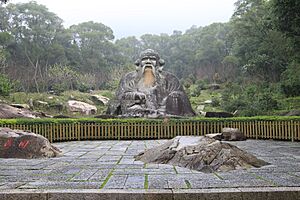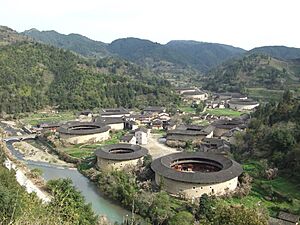Fujian facts for kids
Quick facts for kids
Fujian
福建
Fukien, Hokkien
|
|
|---|---|
| Province of Fujian | |
| Name transcription(s) | |
| • Chinese | 福建省 (Fújiàn Shěng) |
| • Abbreviation | FJ / 闽 (pinyin: Mǐn; Pe̍h-ōe-jī: Bân) |
| • Foochow | Hók-gióng |
| • Hokkien POJ | Hok-kiàn |
|
|
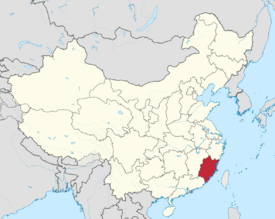
Map showing the location of Fujian province
|
|
| Country | |
| Jiangnandong Circuit | 626 |
| Fujian Circuit | 985 |
| Fujian People's Government | 1933–1934 |
| Named for | 福 Fú: Fuzhou 建 Jiàn: Jianzhou |
| Capital | Fuzhou |
| Largest city | Quanzhou |
| Divisions - Prefecture-level - County-level - Township- level |
9 prefectures 84 counties 1102 towns and subdistricts |
| Government | |
| • Type | Province |
| • Body | Fujian Provincial People's Congress |
| Area | |
| • Total | 121,400 km2 (46,900 sq mi) |
| Area rank | 23rd |
| Highest elevation
(Mt. Huanggang)
|
2,158 m (7,080 ft) |
| Population
(2020)
|
|
| • Total | 41,540,086 |
| • Rank | 15th |
| • Density | 342.18/km2 (886.2/sq mi) |
| • Density rank | 14th |
| Demographics | |
| • Ethnic composition | Han – 98% She – 1% Hui – 0.3% |
| • Languages and dialects | Min (inc. Fuzhounese, Eastern Min, Northern Min, Central Min, Pu-Xian Min, Hokkien and others), Mandarin, She, Hakka |
| GDP (2023) | |
| • Total | CN¥ 5,436 billion (8th) US$ 771 billion |
| • Per capita | CN¥ 129,865 (4th) US$ 18,429 |
| ISO 3166 code | CN-FJ |
| HDI (2022) | 0.804 (7th) – very high |
| Fujian | |||||||||||||||||||||||||||||||||||||||||||||||||||||
|---|---|---|---|---|---|---|---|---|---|---|---|---|---|---|---|---|---|---|---|---|---|---|---|---|---|---|---|---|---|---|---|---|---|---|---|---|---|---|---|---|---|---|---|---|---|---|---|---|---|---|---|---|---|

"Fujian" in Chinese characters
|
|||||||||||||||||||||||||||||||||||||||||||||||||||||
| Chinese | 福建 | ||||||||||||||||||||||||||||||||||||||||||||||||||||
| Postal | Fukien | ||||||||||||||||||||||||||||||||||||||||||||||||||||
| Literal meaning | "Fu(zhou) and Jian(zhou)" | ||||||||||||||||||||||||||||||||||||||||||||||||||||
|
|||||||||||||||||||||||||||||||||||||||||||||||||||||
| Abbreviation | |||||||||||||||||||||||||||||||||||||||||||||||||||||
| Simplified Chinese | 闽 | ||||||||||||||||||||||||||||||||||||||||||||||||||||
| Traditional Chinese | 閩 | ||||||||||||||||||||||||||||||||||||||||||||||||||||
| Literal meaning | [the Min River] | ||||||||||||||||||||||||||||||||||||||||||||||||||||
|
|||||||||||||||||||||||||||||||||||||||||||||||||||||
Fujian is a province in South China. It borders Zhejiang to the north, Jiangxi to the west, and Guangdong to the south. To the east is the Taiwan Strait.
Fujian's capital city is Fuzhou. Its largest city by population is Quanzhou. Other important cities include the port city of Xiamen. Fujian is very close to Taiwan, both geographically and culturally. Some islands like Kinmen are only about 10 kilometers (6.2 miles) from Xiamen.
Most people in Fujian are Han Chinese. But it's one of China's most diverse provinces in terms of culture and languages. Many different Min Chinese dialects are spoken here. These include Fuzhou dialect and Hokkien. People also speak Hakka Chinese. These languages are very different from each other and from Standard Chinese (Mandarin). Many Chinese people in Taiwan, Singapore, Malaysia, Indonesia, and the Philippines speak Hokkien.
Fujian has about 41.5 million people. It ranks 15th in population among Chinese provinces. In 2022, Fujian's economy was very strong. It ranked 8th in China for its total economic output. Fujian's economy per person is also high, ranking second among all Chinese provinces. This is partly because it's close to Taiwan.
Because of the Chinese Civil War, a small part of historical Fujian is now controlled by the Republic of China (ROC). This includes the Kinmen Islands, Matsu Islands, and Wuqiu Islands.
Fujian is known for its excellent education and research. In 2023, Xiamen and Fuzhou were among the top 45 cities worldwide for scientific research.
Contents
Discovering Fujian's Name
The name Fujian (福建) comes from combining two old city names. These are Fuzhou (福州) and Jianzhou (建州). Jianzhou is now called Nanping (南平).
Exploring Fujian's Past
Ancient Times in Fujian
Recent discoveries show that people lived in Fujian during the Neolithic Age (New Stone Age). This was around 6,000 years ago. At sites like Keqiutou, tools made of stone, shells, and bones were found. They also found spinning wheels, which means people were weaving cloth.
Life was simple back then. People mostly fished and hunted. They also did a little farming. There were different cultures in coastal and inland Fujian.
The Minyue Kingdom

Fujian was once home to the Minyue kingdom. The name "Mǐnyuè" comes from "Mǐn," which might be an old name for a group of people. "Yuè" comes from the State of Yue, a kingdom to the north. The royal family of Yue moved to Fujian after their kingdom was taken over in 306 BC.
Fujian in the Qin and Han Dynasties
The Qin dynasty was the first unified Chinese empire. It ended the Minyue kingdom's independent status. But after the Qin dynasty fell, a civil war began. The Minyue king helped Liu Bang, who won and started the Han dynasty.
In 202 BC, Liu Bang made Minyue an independent kingdom again. The Minyue king built a fortified city in Fuzhou. His kingdom grew beyond modern Fujian. Minyue was very strong and fought against neighboring kingdoms.
But the Han dynasty wanted to expand south. In 111 BC, the Han emperor sent a large army to Minyue. The rulers in Fuzhou surrendered to avoid fighting. This ended the first kingdom in Fujian's history.
Later, during the Three Kingdoms era, the Kingdom of Wu spent many years trying to control the Shan Yue people who lived in the mountains.
Early Migrations to Fujian
The first big wave of people moved to Fujian in the early 4th century. This happened when the Western Jin dynasty fell apart. People from central China moved south to escape wars. Many of these immigrants came from eight important families. Even today, four of these family names are very common in Fujian.
Fujian was not as developed as other parts of China for a long time. This was because of its tough mountains. It was often a place where prisoners and people who disagreed with the government were sent.
During the Sui dynasty and Tang dynasty, even more people moved to Fujian. The Tang dynasty was a golden age for China. This helped Fujian's culture and economy grow. Fuzhou became an important economic and cultural center.
The Five Dynasties and Ten Kingdoms Period
After the Tang dynasty, China was divided into many smaller kingdoms. During this time, another large group of people came to Fujian. They were led by the Wang Brothers. They started an independent kingdom called Min, with Fuzhou as its capital. But after the first king died, the kingdom had problems and was later taken over by another kingdom.
Quanzhou city became a busy seaport during this time.
Fujian in the Song and Yuan Dynasties
In 985, the area was officially named the Fujian Circuit. This was the first time the name "Fujian" was used for an administrative region.
During the Yuan dynasty, Fujian was part of a larger province. From 1357 to 1366, there was a rebellion in Quanzhou. After this, Quanzhou lost its importance as a trading port.
Fujian in the Ming and Qing Dynasties
Under the Ming dynasty, Fujian became a province with Fuzhou as its capital. In the early Ming era, Fuzhou was a key place for Zheng He's famous naval expeditions. However, a ban on sea trade slowed down Fujian's growth. Piracy was also a big problem, but the Chinese military eventually stopped it.
Later, during the Qing dynasty, there was another sea trade ban. This was to stop the Ming government on Taiwan. Many people had to move away from the coast. In 1683, the Qing dynasty took control of Taiwan and made it part of Fujian province. Many Han Chinese then moved to Taiwan. Today, most Taiwanese people are descendants of people from Southern Fujian. Fujian and Taiwan were one province until 1885, when they became two separate provinces.
Modern Fujian
The Xinhai revolution ended the Qing dynasty. Fujian then became part of the Republic of China. Fujian briefly had its own government in 1933, but it was soon brought back under the Republic of China's control.
After the Chinese Civil War, the People's Republic of China took over most of Fujian. Only the islands of Kinmen and Matsu remained under Taiwan's control.
For a long time, Fujian grew slower than other coastal provinces. This was because of possible conflicts with Taiwan. But since 1978, Fujian has grown a lot. It has received investments from overseas Chinese and from Taiwan. Fujian now has the highest forest coverage in China.
Fujian faces challenges as it grows. It needs to protect its natural beauty and historical sites.
Fujian's Geography
Fujian is mostly mountainous. People say it's "eight parts mountain, one part water, and one part farmland." The Wuyi Mountains in the northwest form the border with Jiangxi. Fujian has the most forest cover of any province in China, with 62.96% of its land covered by trees in 2009. The highest point is Mount Huanggang, which is 2,157 meters (7,077 feet) tall.
Fujian faces the East China Sea to the east and the Taiwan Strait to the southeast. Its coastline is rough with many bays and islands. Important islands include Quemoy (Kinmen) and Haitan Island. Meizhou Island is famous as the home of Matsu, the goddess of sailors.
The Min River flows through much of northern and central Fujian. Other rivers include the Jin and the Jiulong. Because of its mountains, Fujian has many cliffs and fast-flowing rivers.
Fujian is separated from Taiwan by the 180-kilometer (110-mile) wide Taiwan Strait. Some small islands in the strait are also part of Fujian. However, the islands of Kinmen and Matsu are governed by the Republic of China (Taiwan).
Fujian has a subtropical climate. Winters are mild. In January, coastal areas are about 7–10°C (45–50°F). Summers are hot, and the province can be hit by typhoons from the Pacific Ocean. Fujian gets a lot of rain, about 1,400–2,000 mm (55–79 inches) each year.
Getting Around Fujian
Roads and Highways
As of 2012, Fujian had over 54,876 kilometers (34,098 miles) of highways. This included 3,500 kilometers (2,175 miles) of expressways. The province plans to double its expressway length to 5,500 kilometers (3,418 miles) by 2015.
Railways
Because Fujian is so mountainous, railways came to the province later than to other parts of China. The first train links to neighboring provinces opened in 1959, 2000, and 2009. By 2013, Fujian had four train links to Jiangxi and one to Guangdong. High-speed rail lines connect Fujian with Zhejiang, with trains traveling up to 250 kilometers per hour (155 mph).
Within Fujian, coastal and inland cities are connected by several railway lines. The province plans to increase its railway length to 2,500 kilometers (1,553 miles) to attract investment from Taiwan.
Airports
Fujian has several major airports. These include Fuzhou Changle International Airport, Xiamen Gaoqi International Airport, and Quanzhou Jinjiang International Airport. Xiamen airport can handle over 15 million passengers each year. Fuzhou airport can handle 6.5 million passengers and has direct flights to many places, including Japan, Malaysia, Thailand, Singapore, and Hong Kong.
How Fujian is Governed
The People's Republic of China controls most of Fujian. It divides the province into nine main cities, called prefecture-level cities. These include a special sub-provincial city called Xiamen.
| Administrative divisions of Fujian | ||||||||||
|---|---|---|---|---|---|---|---|---|---|---|

Xiamen
Putian
Sanming
Zhangzhou
Nanping
Longyan
Ningde
☐ Kinmen County and Lienchiang County (Quemoy and Matsu) are administered by
Quanzhou (Kinmen Co.); Lianjiang Co., Fuzhou (most of Matsu Is.); Changle Dist. (Juguang: Dongju Is. & Xiju Is.); Meizhou, Xiuyu Dist., Putian (Wuqiu Is.); Longhai, Zhangzhou (Dongding I.). |
||||||||||
| Division code | Division | Area in km2 | Population 2020 | Seat | Divisions | |||||
| Districts | Counties | CL cities | ||||||||
| 350000 | Fujian Province | 121,400.00 | 41,540,086 | Fuzhou city | 31 | 42 | 11 | |||
| 350100 | Fuzhou city | 12,155.46 | 8,291,268 | Gulou District | 6 | 6 | 1 | |||
| 350200 | Xiamen city | 1,699.39 | 5,163,970 | Siming District | 6 | |||||
| 350300 | Putian city | 4,119.02 | 3,210,714 | Chengxiang District | 4 | 1 | ||||
| 350400 | Sanming city | 22,928.79 | 2,486,450 | Sanyuan District | 2 | 8 | 1 | |||
| 350500 | Quanzhou city | 11,245.00 | 8,782,285 | Fengze District | 4 | 5* | 3 | |||
| 350600 | Zhangzhou city | 12,873.33 | 5,054,328 | Longwen District | 4 | 7 | ||||
| 350700 | Nanping city | 26,280.54 | 2,645,548 | Jianyang District | 2 | 5 | 3 | |||
| 350800 | Longyan city | 19,028.26 | 2,723,637 | Xinluo District | 2 | 4 | 1 | |||
| 350900 | Ningde city | 13,452.38 | 3,146,789 | Jiaocheng District | 1 | 6 | 2 | |||
| Sub-provincial cities
* - including Kinmen County, ROC (Taiwan). Claimed by the PRC. (included in the total Counties' count) |
||||||||||
All the prefecture-level cities except Nanping, Sanming, and Longyan are located along the coast. These nine cities are further divided into 84 smaller areas. These smaller areas include districts, county-level cities, and counties.
The People's Republic of China also claims some islands that are currently controlled by Taiwan. These include parts of Kinmen County and the Matsu Islands.
Fujian's Economy
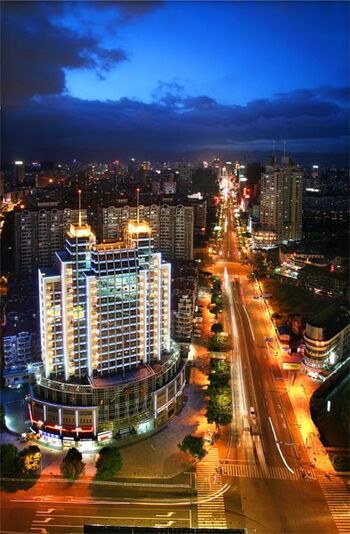
Fujian is one of China's richer provinces. It has many industries, from tea production to clothing and sports brands like Anta and Xtep. Fujian was one of the first provinces allowed to receive money from foreign investors. Many international companies like Boeing and Dell have businesses here. Xiamen was one of China's first special economic zones, which helped its economy grow.
In 2022, Fujian's economy was worth about US$790 billion. This made it the 8th largest economy among Chinese provinces. The money earned per person in Fujian is also higher than the national average. This is the second highest among all Chinese provinces.
Fujian's land is hilly, so there isn't much farmland. Rice is the main crop, along with sweet potatoes and wheat. Fujian is a top producer of longan fruit and also grows a lot of lychees and tea. Seafood is also very important, especially shellfish.
Because of its location near Taiwan, Fujian received less investment from the Chinese government before 1978. After 1978, when China opened up, Fujian got a lot of investment. This came from Fujianese people living overseas, from Taiwan, and from other foreign countries.
The Minnan Golden Triangle, which includes Xiamen, Quanzhou, and Zhangzhou, produces 40% of Fujian's total economic output.
Fujian has benefited greatly from direct transportation links with Taiwan, which started in 2008. This includes direct flights and improved ports for trade. Fujian also hosts the China International Fair for Investment and Trade every year in Xiamen. This event helps promote foreign investment across China.
Special Economic Zones
Fujian has several special zones to encourage business and technology. These include:
- Dongshan Economic and Technology Development Zone
- Fuzhou Economic & Technical Development Zone
- Xiamen Export Processing Zone
- Xiamen Free Trade Zone
- Xiamen Haicang Economic and Technological Development Zone
People of Fujian
In 2021, Fujian had about 41.87 million people. Most people (98%) are Han Chinese. The largest Han Chinese groups are those who speak different Min Chinese dialects. These include Hoklo people, Fuzhounese people, and Putian people.
The Hakka people, who have their own unique culture, live in central and southwestern Fujian. The She people are the largest minority group. They live in the mountainous northern regions.
Many people of Chinese descent around the world, especially in Southeast Asia, have ancestors from Fujian. Most Chinese people in Taiwan, Singapore, and the Philippines have roots in Southern Fujian. People from Eastern Min-speaking areas, like Fuzhou, have also moved to the United States since the 1990s.
Religions in Fujian
Religion in Fujian Chinese ancestral religion (31.31%) Christianity (3.5%) Other religions or not religious people (65.19%)
The main religions in Fujian are traditional Chinese folk religions, Taoism, and Chinese Buddhism. About 30% of people follow Chinese ancestral religion. About 3.5% are Christian. Many other people may not follow a specific religion or practice other faiths like Islam. Fujian is one of the few places where Manichaeism is still practiced.
|
Fujian's Culture

Fujian is one of the most culturally and linguistically diverse places in China. This is because of its mountains and the many people who have moved there over time. People say that "if you drive five miles in Fujian the culture changes, and if you drive ten miles, the language does."
Most languages spoken in Fujian belong to the Min Chinese group. These include:
- Eastern Min (like the Fuzhou dialect)
- Northern Min
- Pu-Xian Min
- Central Min
- Shao-Jiang Min
- Southern Min (like the Amoy dialect and Taiwanese Hokkien)
Hakka Chinese is also spoken in areas like Longyan.
Standard Chinese (Mandarin) is the official language. It is used for communication between people from different areas. However, local people still speak their native languages and dialects.
Fujian has its own types of Chinese opera. Min opera is popular around Fuzhou. Gaojiaxi is popular near Quanzhou.
Fujian cuisine focuses on seafood. It is one of the eight great traditions of Chinese cuisine. A famous dish is Fotiaoqiang, which means "Buddha jumps over the wall." It's a complex dish with many ingredients like shark fin and sea cucumber.
Many famous teas come from Fujian. These include oolong, Lapsang souchong, and Fuzhou jasmine tea. The methods for making oolong, white tea, and black tea were all developed in Fujian. The English word "tea" actually comes from the Hokkien dialect.
Nanyin is a popular type of music of Fujian. Fujian is also known for its special lacquer ware and Shoushan stone carvings.
Fun Places to Visit in Fujian
Fujian has many exciting places to visit. It has four UNESCO World Heritage Sites, which is a lot for one province!
Cultural Wonders
The Fujian Tulou are unique round or square buildings. They were built by the Hakka people in southwest Fujian. These 46 buildings became a World Heritage Site in 2008.
Gulangyu Island in Xiamen is famous for its beaches, winding paths, and beautiful buildings. It's a top tourist spot. Also in Xiamen is the South Putuo Temple, a peaceful Buddhist temple.
The Guanghua Temple in Putian is a Buddhist temple built a long time ago. Meizhou Island is a special place for the goddess Matsu. The Kaiyuan Temple in Quanzhou is the largest Buddhist temple in Fujian.
In Fuzhou, you can visit the Yongquan Temple, a Buddhist temple built during the Tang dynasty. The Chongwu Army Temple honors soldiers who died in 1949.
Natural Beauty
Mount Taimu is a beautiful mountain resort in Fuding. It offers amazing views of mountains and the sea. It's known for its granite caves, unique stones, and waterfalls.
The Danxia landform in Taining became a World Heritage Site in 2010. These are special red rock formations that look like karst landscapes. They were formed by natural forces over millions of years.
The Wuyi Mountains were the first place in Fujian to become a World Heritage Site in 1999. This mountain range in Nanping has Fujian's highest peak, Mount Huanggang. It's known for its stunning natural scenery and is a popular summer getaway.
Famous People from Fujian
Fujian and its people around the world are known for their achievements in education and other fields. Many important scholars, leaders, and famous people have come from Fujian. This includes people whose ancestors were from Fujian. Many people of Chinese descent in Taiwan and Southeast Asia can trace their family roots back to Fujian.
Some notable individuals include:
- Zhu Xi (1130–1200), a famous philosopher.
- Lin Zexu (1785–1850), a Qing dynasty official.
- Lin Yutang (1894–1976), a well-known writer.
- Bing Xin (1900–1999), a famous writer.
- Go Seigen (1914–2014), a legendary Go player.
- Chen Jingrun (1933–1996), a brilliant mathematician.
- Chen Kaige (born 1952), a famous film director.
- Lin Dan (born 1983), a professional badminton player.
- Zhang Yiming (born 1983), founder of ByteDance (TikTok's parent company).
Sports in Fujian
Fujian has professional sports teams. These include basketball and soccer teams.
The Fujian Sturgeons are the province's basketball team. They play in the Chinese Basketball Association. They started playing in 2004.
In soccer, the province is represented by Fujian Tianxin F.C.. They play in the China League Two.
Education and Research in Fujian
Fujian is a leading province in China for education and research. In 2023, two of its major cities, Xiamen and Fuzhou, were ranked among the top 45 cities globally for scientific research.
High Schools
- Fuzhou Gezhi High School
- Fuzhou No.1 Middle School
- Xiamen Shuangshi High School
Colleges and Universities
National Universities
- Xiamen University (founded 1921)
- Huaqiao University
Provincial Universities
- Fuzhou University (founded 1958)
- Fujian Agriculture and Forestry University
- Fujian Normal University
- Jimei University
- Minnan Normal University
- Wuyi University
Private Universities
- Yang-En University
See also
 In Spanish: Fujian para niños
In Spanish: Fujian para niños







